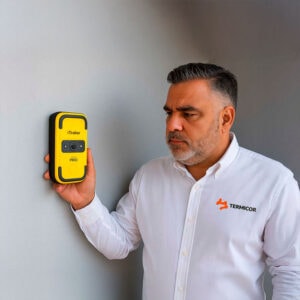Subterranean termites are one of the most destructive pests we can find in wooden structures. Unlike other insects, they live underground and are organized into complex colonies, where each member has a specific function. One of the most widespread myths is that killing the queen solves the problem, but is it really that easy?
We have been closely studying the behaviour of subterranean termites in Mallorca for years, both in homes and in historic buildings. And we know that eliminating them is not as simple as killing a single insect. Here we explain how the colony is organized, what happens when the queen dies and why the key is to intervene in a professional and planned way.
How an underground termite colony works
Subterranean termites (genus Reticulitermes, among others) live organized in underground colonies. Unlike woodworm or other wood pests, you don’t see the damage until it’s well advanced, because it accesses from the ground, builds hidden galleries, and consumes the wood from within.
A typical colony is made up of:
- One or more queens: they lay thousands of eggs every year.
- A king: periodically inseminates the queen.
- Workers: responsible for foraging for food, building tunnels, and feeding others.
- Soldiers: they defend the colony from enemies, such as ants.
- Winged (breeding): they are those that come out during the nuptial flight.
The system is so efficient that colonies can have thousands or even millions of individuals running non-stop, hidden underground, for years.
Does killing the queen end the plague?
The short answer: not necessarily.
Although it is true that the queen is the main breeder of the colony, her death does not guarantee the end of the plague, and we explain why:
- Colonies usually have secondary breeders: if the queen dies, another member of the colony can take over her reproductive role. Some species generate replacement queens as soon as they detect the absence of pheromones.
- Locating the queen is almost impossible without professional intervention: queens live deep underground, heavily protected by soldiers and workers. In traditional or home treatments, they are not reached.
- The structure of the colony is resilient: even if part of the colony dies, the survivors can regroup and create new pockets.
For this reason, at Termicor we work with biological bait systems or localized treatments that eliminate the entire colony from within. The workers carry the product to the queen, without having to find her directly.
The nuptial flight: the great clue to detect a plague
One of the few times that subterranean termites become visible is during the nuptial flight, which usually occurs in spring, when temperatures rise and there is some ambient humidity (usually after rainy days).
What is the bridal flight?
This is the time when the winged (male and female termite with wings) go outside to mate and found new colonies. After the flight:
- They lose their wings.
- They look for a damp and dark place (such as the basement of a house).
- Start a new colony with a new queen.
How do you know if you are watching it?
- You’ll see small winged insects coming out in groups from baseboards, door joints, or cracks in the ground.
- You can find loose wings on the ground or windowsills, as they lose them shortly after leaving.
- It often occurs in April or May in Mallorca, coinciding with mild and somewhat humid days.
This moment is key to detect an early infestation, since, if they have hatched winged, that means that the colony is already developed.
What to do if you see signs of termites?
The most important thing is not to underestimate the situation. Subterranean termites make no noise, do not leave visible sawdust like woodworm, and can take years to give obvious signs. But when they do, the damage is usually already significant.
These are the actions that we recommend from Termicor:
- Don’t use generic hardware products – they can cause the colony to split and the problem to spread.
- Do not dismantle structures on your own: you could destroy important clues for diagnosis.
- Call us for a specialized inspection: we use detection equipment such as moisture meters, cameras or even our resistograph (if the condition of the beams needs to be assessed).
You can check here our professional termite treatment service, where we explain more about the bait system, deadlines and guarantees.
Effective treatment starts with understanding the pest
At Termicor we do not apply products “like crazy”. The first thing we do is diagnose the situation well: see where they access, at what points the colony is active, which areas are at risk and what type of structure needs to be protected.
Our experience with subterranean termites in Mallorca has taught us something very clear: each case is different and deserves an adapted solution.
We use techniques that:
- They eliminate the colony from within.
- They avoid creating secondary colonies by mistake.
- They do not damage the wood or the environment.
- They are safe for people and pets.
And most importantly: we do not promise instant miracles, but we do work with proven effectiveness and professional follow-up. This not only solves the problem… it is prevented from returning.
Have you seen wings at home?
Don’t miss it. The sooner you act, the easier it will be to remove the colony without having to make major repairs. Write to us or call us without obligation: we will make a professional assessment and explain step by step what to do.


